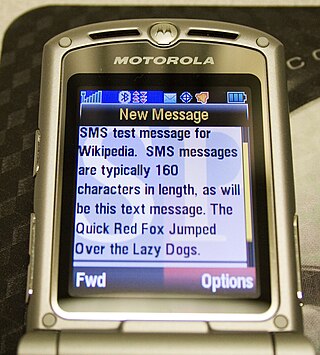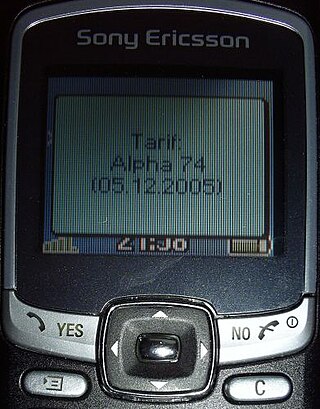Related Research Articles

The Global System for Mobile Communications (GSM) is a standard developed by the European Telecommunications Standards Institute (ETSI) to describe the protocols for second-generation (2G) digital cellular networks used by mobile devices such as mobile phones and tablets. GSM is also a trade mark owned by the GSM Association. "GSM" may also refer to the voice codec initially used in GSM.

General Packet Radio Service (GPRS), also called 2.5G, is a mobile data standard on the 2G cellular communication network's global system for mobile communications (GSM). Networks and mobile devices with GPRS started to roll out around the year 2001. At the time of introduction it offered for the first time seamless mobile data transmission using packet data for an "always-on" connection, providing improved Internet access for web, email, WAP services, and Multimedia Messaging Service (MMS).

Short Message Service, commonly abbreviated as SMS, is a text messaging service component of most telephone, Internet and mobile device systems. It uses standardized communication protocols that let mobile phones exchange short text messages, typically transmitted over cellular networks.
In telecommunication, a public land mobile network (PLMN) is a combination of wireless communication services offered by a specific operator in a specific country. A PLMN typically consists of several cellular technologies like GSM/2G, UMTS/3G, LTE/4G, NR/5G, offered by a single operator within a given country, often referred to as a cellular network.
The international mobile subscriber identity is a number that uniquely identifies every user of a cellular network. It is stored as a 64-bit field and is sent by the mobile device to the network. It is also used for acquiring other details of the mobile in the home location register (HLR) or as locally copied in the visitor location register. To prevent eavesdroppers from identifying and tracking the subscriber on the radio interface, the IMSI is sent as rarely as possible and a randomly-generated TMSI is sent instead.

A SIMcard is an integrated circuit (IC) intended to securely store an international mobile subscriber identity (IMSI) number and its related key, which are used to identify and authenticate subscribers on mobile telephone devices. SIMs are also able to store address book contacts information, and may be protected using a PIN code to prevent unauthorized use.

The International Mobile Equipment Identity (IMEI) is a numeric identifier, usually unique, for 3GPP and iDEN mobile phones, as well as some satellite phones. It is usually found printed inside the battery compartment of the phone but can also be displayed on-screen on most phones by entering the MMI Supplementary Service code *#06# on the dialpad, or alongside other system information in the settings menu on smartphone operating systems.
Mobility management is one of the major functions of a GSM or a UMTS network that allows mobile phones to work. The aim of mobility management is to track where the subscribers are, allowing calls, SMS and other mobile phone services to be delivered to them.
A global title (GT) is an address used in the SCCP protocol for routing signaling messages on telecommunications networks. In theory, a global title is a unique address which refers to only one destination, though in practice destinations can change over time.

Unstructured Supplementary Service Data (USSD), sometimes referred to as "quick codes" or "feature codes", is a communications protocol used by GSM cellular telephones to communicate with the mobile network operator's computers. USSD can be used for WAP browsing, prepaid callback service, mobile-money services, location-based content services, menu-based information services, and as part of configuring the phone on the network. The service does not require a messaging app, and does not incur charges.
MSISDN is a number uniquely identifying a subscription in a Global System for Mobile communications or a Universal Mobile Telecommunications System mobile network. It is the mapping of the telephone number to the subscriber identity module in a mobile or cellular phone. This abbreviation has several interpretations, the most common one being "Mobile Station International Subscriber Directory Number".
Adaptive Multi-Rate Wideband (AMR-WB) is a patented wideband speech audio coding standard developed based on Adaptive Multi-Rate encoding, using a similar methodology to algebraic code-excited linear prediction (ACELP). AMR-WB provides improved speech quality due to a wider speech bandwidth of 50–7000 Hz compared to narrowband speech coders which in general are optimized for POTS wireline quality of 300–3400 Hz. AMR-WB was developed by Nokia and VoiceAge and it was first specified by 3GPP.
3GP is a multimedia container format defined by the Third Generation Partnership Project (3GPP) for 3G UMTS multimedia services.
APN settings connect the device to the internet via mobile carrier’s cellular network. These settings include IP addresses, gateways, and other technical details that enable the device to access the internet and send MMS.
Inn mobile networks, location area identity (LAI) is a unique identifier assigned to each location area of a public land mobile network (PLMN).

Cell Broadcast (CB) is a method of sending short messages to multiple mobile telephone users in a defined area at the same time. It is defined by the ETSI's GSM committee and 3GPP and is part of the 2G, 3G, 4G LTE (telecommunication) and 5G standards. It is also known as Short Message Service-Cell Broadcast . Unlike Short Message Service-Point to Point (SMS-PP), Cell Broadcast is a one-to-many geo-targeted and geo-fenced messaging service.
The ITU-T Recommendation E.212 defines mobile country codes (MCC) as well as mobile network codes (MNC).

In telecommunications, a femtocell is a small, low-power cellular base station, typically designed for use in a home or small business. A broader term which is more widespread in the industry is small cell, with femtocell as a subset. It typically connects to the service provider's network via the Internet through a wired broadband link ; current designs typically support four to eight simultaneously active mobile phones in a residential setting depending on version number and femtocell hardware, and eight to sixteen mobile phones in enterprise settings. A femtocell allows service providers to extend service coverage indoors or at the cell edge, especially where access would otherwise be limited or unavailable. Although much attention is focused on WCDMA, the concept is applicable to all standards, including GSM, CDMA2000, TD-SCDMA, WiMAX and LTE solutions.
The (U)SIM interface is the connecting point of the mobile phone and the UICC with its SIM or USIM application.
References
- ↑ 3GPP TS 23.003 §4.3.1 "Cell Identity (CI) and Cell Global Identification (CGI)" https://www.etsi.org/deliver/etsi_ts/123000_123099/123003/15.04.00_60/ts_123003v150400p.pdf
- ↑ 3GPP TS 48.008 §3.2.1.9 "HANDOVER REQUIRED" and §3.2.2.17 "Cell Identifier" https://www.etsi.org/deliver/etsi_ts/148000_148099/148008/15.00.00_60/ts_148008v150000p.pdf
- ↑ "Mobile Country Codes (MCC) and Mobile Network Codes (MNC)".
- ↑ "Location Based Services System overview". ERICSSON. 2009. Archived from the original on January 6, 2010. Retrieved 2009-05-25.